Yeni başlayanlar bize sık sık web sitelerini SSL veya HTTPS’ye taşıma konusunda sorular soruyor. Bu terimler kulağa çok teknik gelebilir, ancak aslında bunu yapmak çok kolaydır.
Bir web sitesinin URL’sindeki HTTPS, bir SSL sertifikası yükleyerek güvenli bir veri aktarım protokolü kullandığı anlamına gelir. Bu önemlidir çünkü çoğu modern tarayıcı HTTPS kullanmayan web siteleri için uyarılar gösterir.
Neyse ki, en güvenilir hosting şirketleri ve WordPress web sitenizin güvenliğini sağlamayı çok kolay hale getiriyor.
Bu makalede, bir SSL sertifikası ekleyerek WordPress’inizi HTTP’den HTTPS’ye nasıl taşıyacağınızı göstereceğiz. SSL veya HTTPS’nin ne olduğunu bilmiyorsanız endişelenmeyin. Bunu da açıklayacağız.
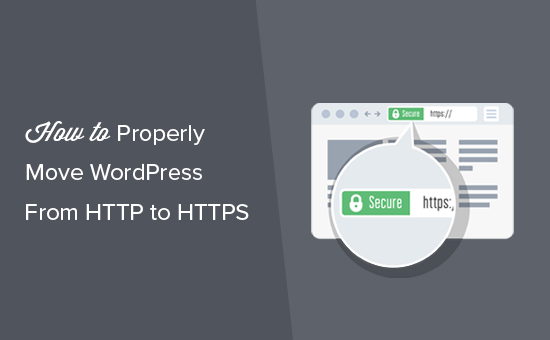
İşte bu makalede ele alacağımız konulara hızlı bir genel bakış:
- What Is HTTPS?
- Why Do You Need HTTPS and SSL?
- Requirements for Using HTTPS/SSL on a WordPress Site
- Setting Up WordPress to Use SSL and HTTPS
- Method 1: Setup SSL/HTTPS in WordPress Using a Plugin
- Method 2: Set Up SSL/HTTPS in WordPress Manually
- Submit Your HTTPS Site to Google Search Console
- Bonus Resources
- Video Tutorial
HTTPS Nedir?
HTTPS veya Güvenli HTTP, bir kullanıcının tarayıcısı ile sunucunuz arasındaki bağlantıyı güvence altına alan bir şifreleme yöntemidir. Bu ek güvenlik, bilgisayar korsanlarının aktarılan verileri ele geçirmesini çok daha zor hale getirir.
İnsanlar her gün, ister alışveriş yapıyor ister sadece oturum açıyor olsunlar, kişisel bilgilerini web siteleriyle paylaşıyor. Bu tür veri alışverişini korumanın ne kadar önemli olduğunu ilk elden gördük.
Veri güvenliğini sağlamak için güvenli bir bağlantı kurulması gerekir.
SSL ve HTTPS bu noktada devreye girer.
Her web sitesi tanımlama için benzersiz bir SSL sertifikası alır. Bir sunucu geçerli bir sertifika olmadan HTTPS kullanmaya çalışırsa veya sertifika eşleşmezse, çoğu modern tarayıcı kullanıcıları uyarır ve devam etmemelerini önerir.
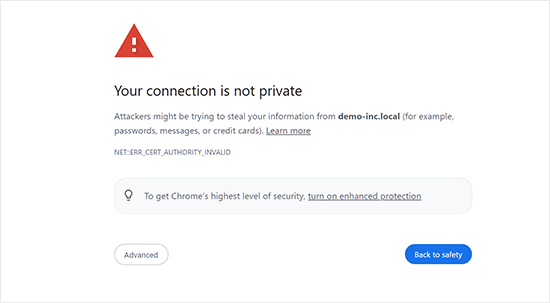
Şimdi, WordPress sitenizi HTTP’den HTTPS’ye taşımanın neden gerekli olduğunu merak edebilirsiniz, özellikle de ödemeleri işlemeyen basit bir blog veya küçük işletme web sitesiyse.
HTTPS ve SSL’e Neden İhtiyacınız Var?
2018 yılında Google, site sahiplerini HTTP’den HTTPS’ye geçmeye teşvik ederek web güvenliğini artırmaya yönelik bir girişim duyurdu. Bu girişimi desteklemek için Chrome tarayıcıları SSL sertifikası olmayan tüm web sitelerini “Güvenli Değil” olarak işaretlemeye başladı.
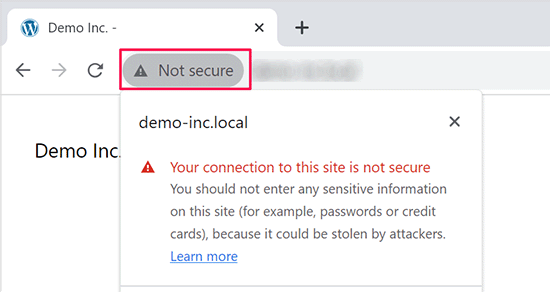
Google ayrıca SSL’li sitelerin SEO avantajları elde edeceğini ve güvenli olmayan sitelere göre daha yüksek arama sıralamaları elde edebileceğini belirtti. Bu duyuru birçok site sahibini HTTPS’ye geçmeye itti.
“Güvenli Değil” uyarısı yayınlandıktan sonra Chrome HTTP sitelerini işaretlemeye başladı. Örneğin, bir HTTP sitesini gizli modda ziyaret etmek veya bir HTTP sitesinde iletişim formu doldurmak uyarıyı tetikleyerek siteyi güvensiz olarak işaretliyor.
Ziyaretçiler bu uyarıyı gördüğünde, siteniz veya işletmeniz hakkında olumsuz bir izlenim bırakabilir.
Bu nedenle tüm web sitelerinin mümkün olan en kısa sürede HTTPS’ye geçmesi ve SSL yüklemesi gerekir.
Ayrıca, e-ticaret sitenizde çevrimiçi ödemeleri kabul etmek istiyorsanız SSL bir zorunluluktur.
Stripe, PayPal Pro ve Authorize.net gibi ödeme sağlayıcıları güvenli bir ödeme bağlantısı gerektirir.
WPBeginner, OptinMonster, WPForms ve MonsterInsights dahil olmak üzere kendi sitelerimizin SSL kullanmasını sağlıyoruz.
WordPress Sitesinde HTTPS/SSL Kullanmak için Gerekenler
WordPress’te SSL kullanmak için gerekenler çok yüksek değildir. Tek yapmanız gereken bir SSL sertifikası satın almaktır ve buna zaten ücretsiz olarak sahip olabilirsiniz.
En iyi WordPress hosting şirketleri tüm kullanıcıları için ücretsiz SSL sertifikaları sunuyor:
Daha fazla ayrıntı için WordPress web siteniz için nasıl ücretsiz SSL sertifikası alacağınıza ilişkin kılavuzumuza bakın.
Hosting şirketiniz ücretsiz bir SSL sertifikası sunmuyorsa, bir tane satın almanız gerekir.
Domain.com’u öneriyoruz çünkü normal ve joker SSL sertifikaları için en iyi SSL anlaşmasını sunuyor.
Onlardan bir SSL sertifikası satın alarak, web siteniz için bir TrustLogo site mührü de elde edersiniz. Her SSL sertifikası minimum 10.000 $ güvenlik garantisi ile birlikte gelir. Fiyatlandırma yıllık 33$’dan başlar ve SSL sertifikaları otomatik olarak yenilenir.
Bir SSL sertifikası satın aldıktan sonra, barındırma sağlayıcınızdan bunu sizin için yüklemesini istemeniz gerekir.
SSL Kurma ve HTTPS’ye Geçme Konusunda Yardıma mı İhtiyacınız Var?
SSL kurmak için zamanınız yoksa, Premium WordPress Destek hizmetimiz size yardımcı olmak için burada! Tüm süreci sizin için halledebilir, sitenizin güvenli ve ziyaretçiler için hazır olmasını sağlayabiliriz.
- Tek seferlik ücret
- Hızlı geri dönüş süreleri
- 7/24 talep üzerine kullanılabilir
Sitenizin uzman ellerde olduğunu bilerek içiniz rahat olabilir. Sorunsuz SSL kurulumu ve HTTPS geçişi için bugün bize ulaşın!
WordPress’i SSL ve HTTPS Kullanacak Şekilde Ayarlama
Alan adınız için bir SSL sertifikası etkinleştirdikten sonra, WordPress’i web sitenizde SSL ve HTTP protokollerini kullanacak şekilde ayarlamanız gerekecektir.
Bunu yapmak için size iki yöntem göstereceğiz ve ihtiyaçlarınıza en uygun olanı seçebilirsiniz.
Yöntem 1: Bir Eklenti Kullanarak WordPress’te SSL/HTTPS Kurun
Bu yöntem daha kolaydır ve yeni başlayanlar için tavsiye edilir.
Öncelikle Really Simple SSL eklentisini yüklemeniz ve etkinleştirmeniz gerekir. Daha fazla ayrıntı için, bir WordPress eklentisinin nasıl kurulacağına ilişkin adım adım kılavuzumuza bakın.
Etkinleştirmenin ardından Ayarlar ” SSL sayfasını ziyaret etmeniz gerekir. Eklenti SSL sertifikanızı otomatik olarak algılayacak ve WordPress sitenizi HTTPS kullanacak şekilde ayarlayacaktır.
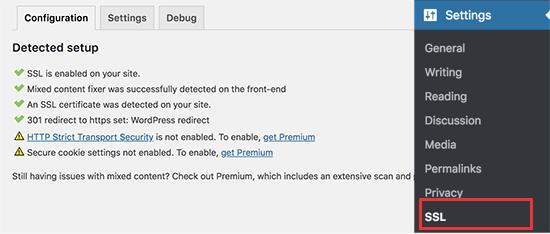
Eklenti, karışık içerik hataları da dahil olmak üzere her şeyi halledecektir. İşte eklentinin perde arkasında yaptıkları:
- SSL sertifikasını kontrol edin
- WordPress’i URL’lerde https kullanacak şekilde ayarlama
- HTTP’den HTTPS’yeyönlendirmeleri ayarlama
- İçeriğinizde hala güvensiz HTTP kaynaklarından yüklenen URL’leri arayın ve bunları düzeltmeye çalışın.
Not: Eklenti, karışık içerik hatalarını bir çıktı tamponlama tekniği kullanarak düzeltmeye çalışır. Bu, sayfa yüklenirken sitedeki içeriği değiştirdiği için olumsuz bir performans etkisine sahip olabilir. Bu etki yalnızca ilk sayfa yüklemesinde görülür ve bir önbellekleme eklentisi kullanıyorsanız minimum düzeyde olmalıdır.
Eklenti SSL’i koruyabileceğinizi ve eklentiyi güvenli bir şekilde devre dışı bırakabileceğinizi söylese de, bu %100 doğru değildir. Eklentiyi devre dışı bırakmak karışık içerik hatalarını geri getireceğinden eklentiyi her zaman aktif bırakmanız gerekecektir. Daha fazla ayrıntı için Really Simple SSL incelememize bakın.
Yöntem 2: WordPress’te SSL/HTTPS’yi Manuel Olarak Kurun
Bu yöntem, sorunları manuel olarak gidermenizi ve WordPress dosyalarını düzenlemenizi gerektirir. Bununla birlikte, kalıcı ve daha performanslı bir çözümdür ve WPBeginner’da kullanıyoruz.
Bu yöntemi zor buluyorsanız, bir WordPress geliştiricisi tutmalı veya bunun yerine ilk yöntemi kullanmalısınız.
Bu yöntemin bir parçası olarak WordPress temasını ve kod dosyalarını düzenlemeniz gerekebilir. Bunu daha önce yapmadıysanız, WordPress’te kod parçacıklarını kopyalama ve yapıştırma kılavuzumuza bakın.
İlk olarak, Ayarlar ” Genel sayfasını ziyaret etmeniz gerekir. Buradan WordPress ve site URL adresi alanlarınızı http yerine https yazarak güncellemeniz gerekiyor.
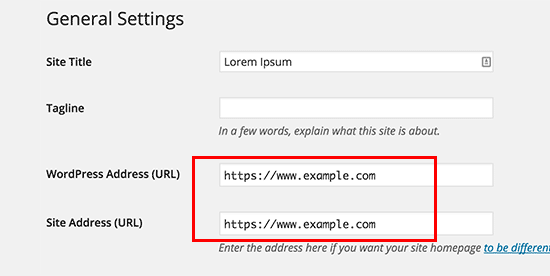
Ayarlarınızı kaydetmek için ‘Değişiklikleri kaydet’ düğmesine tıklamayı unutmayın.
Ayarlar kaydedildikten sonra WordPress oturumunuzu kapatacak ve yeniden giriş yapmanız istenecektir.
Ardından, .htaccess dosyanıza aşağıdaki kodu ekleyerek WordPress yönlendirmelerini HTTP’den HTTPS’ye ayarlamanız gerekir:
1 2 3 4 5 | <IfModule mod_rewrite.c>RewriteEngine OnRewriteCond %{HTTPS} offRewriteRule ^(.*)$ https://%{HTTP_HOST}%{REQUEST_URI} [L,R=301]</IfModule> |
Eğer NGINX sunucular kullanıyorsanız, HTTP’den HTTPS’ye yönlendirmek için aşağıdaki kodu yapılandırma dosyanıza eklemeniz gerekecektir:
1 2 3 4 5 | server {listen 80;server_name example.com www.example.com;return 301 https://example.com$request_uri;} |
example.com yerine kendi alan adınızı yazmayı unutmayın.
Bu adımları izleyerek WordPress HTTPS çalışmıyor hatasını önleyeceksiniz çünkü WordPress artık tüm web sitenizi HTTPS kullanarak yükleyecektir.
WordPress yönetici alanınızda veya giriş sayfalarınızda SSL ve HTTPS’yi zorlamak istiyorsanız, wp-config.php dosyasında SSL’yi yapılandırmanız gerekir.
Aşağıdaki kodu wp-config.php dosyanızdaki “Hepsi bu kadar, düzenlemeyi durdurun!” satırının üzerine ekleyin:
1 | define('FORCE_SSL_ADMIN', true); |
Bu satır WordPress’in WordPress yönetici alanında SSL / HTTP’leri zorlamasını sağlar. WordPress çoklu site ağlarında da çalışır.
Bunu yaptığınızda, web siteniz SSL / HTTPS kullanmak için tamamen ayarlanmış olur, ancak yine de karışık içerik hatalarıyla karşılaşırsınız.
Bu hatalar, URL’lerde hala güvensiz HTTP protokolü kullanılarak yüklenen kaynaklardan (resimler, komut dosyaları veya stil sayfaları) kaynaklanır. Bu durumda, web sitenizin adres çubuğunda güvenli bir asma kilit simgesi göremezsiniz.

Birçok modern tarayıcı güvenli olmayan komut dosyalarını ve kaynakları otomatik olarak engeller.
Tarayıcınızın adres çubuğunda bir asma kilit simgesi ancak bununla ilgili bir bildirim görebilirsiniz.
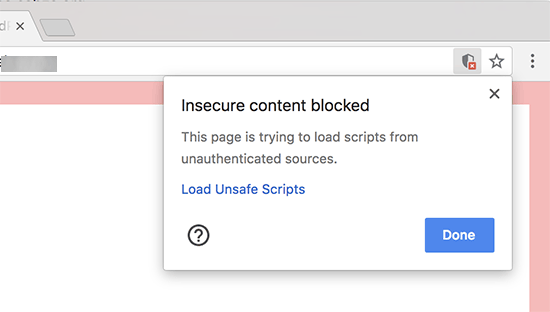
Inspect aracını kullanarak hangi içeriğin güvensiz protokol üzerinden sunulduğunu öğrenebilirsiniz.
Karışık içerik hatası, her bir karışık içerik öğesi için ayrıntılarla birlikte konsolda bir uyarı olarak görüntülenecektir.

URL’lerin çoğunun resimler, iframe’ler ve resim galerileri olduğunu, bazılarının ise WordPress eklentileriniz ve temalarınız tarafından yüklenen komut dosyaları ve stil sayfaları olduğunu fark edeceksiniz.
WordPress Veritabanındaki Karışık İçeriği Düzeltme
Hatalı URL’lerin çoğu WordPress veritabanınızda depolanan resimler, dosyalar, yerleştirmeler ve diğer veriler olacaktır. Önce bunları düzeltelim.
Veritabanında HTTP ile başlayan eski web sitenizin URL’sinden bahseden tüm ifadeleri bulmanız ve bunları HTTPS ile başlayan yeni web sitenizin URL’si ile değiştirmeniz en iyisi olacaktır.
Search & Replace Everything eklentisini yükleyip etkinleştirerek bunu kolayca yapabilirsiniz. Daha fazla ayrıntı için, bir WordPress eklentisinin nasıl kurulacağına ilişkin adım adım kılavuzumuza bakın.
Etkinleştirmenin ardından Araçlar ” WP Search & Replace sayfasını ziyaret etmeniz gerekir. ‘Ara’ alanının altında, web sitenizin URL’sini http ile eklemeniz gerekir. Bundan sonra, web sitenizin URL’sini ‘Değiştir’ alanının altına https ile ekleyin.

Bunun altında, tüm WordPress veritabanı tablolarınızı göreceksiniz.
Kapsamlı bir kontrol yapmak için hepsini seçmeniz gerekir.

Ardından, eklentinin yapacağı tüm değişiklikleri görmek için ‘Arama ve Değiştirmeyi Önizle’ düğmesine tıklayın.
Son olarak, ‘Tümünü Değiştir’ düğmesine tıklayın.
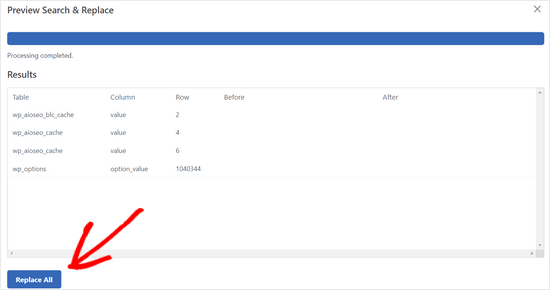
Eklenti şimdi WordPress veritabanınızda http ile başlayan URL’leri arayacak ve bunları güvenli https URL’leri ile değiştirecektir. WordPress veritabanınızın boyutuna bağlı olarak bu işlem biraz zaman alabilir.
WordPress Temasında Karışık İçerik Hatalarını Düzeltme
Karışık içerik hatalarına neden olan bir diğer yaygın suçlu da WordPress temanızdır. WordPress kodlama standartlarını takip eden herhangi bir düzgün WordPress teması bu soruna neden olmaz.
İlk olarak, kaynakları ve nereden yüklendiklerini bulmak için tarayıcınızın İnceleme aracını kullanmanız gerekecektir.

Bundan sonra, bunları WordPress temanızda bulmanız ve https ile değiştirmeniz gerekecektir. Bu yeni başlayanlar için biraz zor olacaktır çünkü hangi tema dosyalarının bu URL’leri içerdiğini göremeyeceksiniz.
Eklentilerden Kaynaklanan Karışık İçerik Hatalarını Düzeltme
Bazı karışık içerik kaynakları WordPress eklentileri tarafından yüklenecektir. WordPress kodlama standartlarına uyan herhangi bir WordPress eklentisi karışık içerik hatalarına neden olmaz.
WordPress eklenti dosyalarını düzenlemenizi önermiyoruz. Bunun yerine, eklenti yazarıyla iletişime geçmeli ve onlara bildirmelisiniz. Yanıt vermezlerse veya sorunu çözemezlerse, uygun bir alternatif bulmalısınız.
Not: Herhangi bir nedenle hala karışık içerik hatasıyla karşılaşıyorsanız, sorunu bir hazırlık web sitesinde çözerken veya bir geliştirici tutarken kullanıcılarınızın etkilenmemesi için geçici olarak Really Simple SSL eklentisini kullanmanızı öneririz.
HTTPS Sitenizi Google Search Console’a Gönderin
Google gibi arama motorları https ve http’yi iki farklı web sitesi olarak kabul eder. Herhangi bir SEO sorunundan kaçınmak için Google’a web sitenizin taşındığını bildirmeniz gerekecektir.
Bunu yapmak için Google Search Console hesabınıza gitmeniz ve ‘Özellik ekle’ düğmesine tıklamanız yeterlidir.

Bu, web sitenizin yeni https adresini eklemeniz gereken bir açılır pencere getirecektir.
Site doğrulaması için iki yöntem vardır: alan adı veya URL öneki. Daha esnek olduğu için URL öneki yöntemini öneriyoruz.
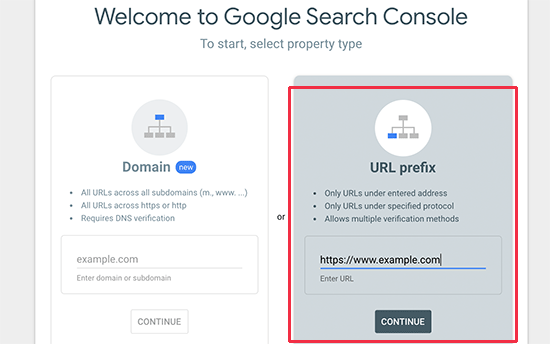
Bundan sonra, Google sizden web sitenizin sahipliğini doğrulamanızı isteyecektir.
Bunu yapmanın birkaç yolu vardır. Herhangi bir yöntemi seçtiğinizde sitenizi doğrulamak için talimatlar alacaksınız. HTML etiketi yöntemini kullanmanızı öneririz.
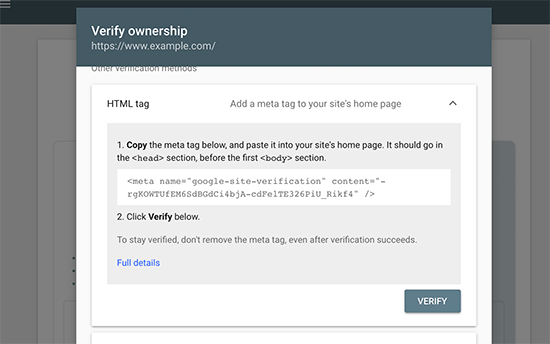
Şimdi WordPress web sitenizin head bölümüne eklemeniz gereken bir HTML kod parçacığı göreceksiniz.
All in One SEO kullanarak Search Console Doğrulama Kodu Ekleme
İlk olarak, WordPress için All in One SEO eklentisini kurun ve etkinleştirin. Daha fazla ayrıntı için WordPress eklentisi yükleme hakkındaki eğitimimize bakın.
Not: All in One SEO ‘nun deneyebileceğiniz ücretsiz bir sürümü de bulunmaktadır.
Etkinleştirmenin ardından All in One SEO ” Genel Ayarlar sayfasına gidin ve Google Search Console’a tıklayın.

Bunun altına, daha önce Google Search Console web sitesinden kopyaladığınız doğrulama kodunu eklemeniz gerekir.
Ayarlarınızı kaydetmek için ‘Değişiklikleri Kaydet’ düğmesine tıklamayı unutmayın.
Ardından, Google Search Console sekmesine geri dönün ve ‘Doğrula’ düğmesine tıklayın.

Siteniz doğrulandıktan sonra Google, search console raporlarınızı burada gösterecektir.
Ayrıca hem https hem de http sürümlerinin Search Console’a eklendiğinden emin olmanız gerekir.
Bu, Google’a web sitenizin https sürümünün birincil sürüm olarak ele alınmasını istediğinizi söyler. Daha önce ayarlanan 301 yönlendirmeleriyle birlikte Google, arama sıralamalarınızı web sitenizin https sürümüne aktaracak ve büyük olasılıkla arama sıralamalarınızda iyileşmeler göreceksiniz.
Bonus Kaynaklar
Aşağıda, yaygın WordPress sorunlarını kendi başınıza çözmenize ve WordPress hakkında daha fazla bilgi edinmenize yardımcı olabilecek birkaç ek kaynak bulunmaktadır:
- WordPress’te Yaygın SSL Sorunları Nasıl Giderilir (Başlangıç Kılavuzu)
- En Yaygın WordPress Hataları ve Nasıl Düzeltilir?
- TLS vs SSL: WordPress için Hangi Protokolü Kullanmalısınız?
- WordPress’te Güvenli Bağlantı Hatası Nasıl Giderilir
Video Eğitimi
Umarız bu makale WordPress’e HTTPS ve SSL eklemenize yardımcı olmuştur. WordPress sitenizi güvende tutmak için adım adım talimatlar içeren nihai WordPress güvenlik kılavuzumuzu veya SSL sertifikanızı nasıl yenileyeceğinizi de görmek isteyebilirsiniz.
If you liked this article, then please subscribe to our YouTube Channel for WordPress video tutorials. You can also find us on Twitter and Facebook.





Weslry
This article is a little bit trap for newbie because if you first change to https in your wp panel and then try to add those codelines to right files you can’t reach your webiste or wp admin panel. (443 error) I had to edit files through ftp and made myself fool at work for making such a mistake. So first you have to get the certificates and edit htaccess file etcetc and then add that S in your wp admin panel (or directly edit thorugh ftp).
Daryl
Thanks for heads up ! good article
Huseyn
Hi! Thank you for this article. Very useful!
But I was faced with one problem. After installing SSL (I use free version of Cloudflare SSL) I cannot edit any pages/posts/products. Does anybody face with such problem? And how did you solve it?
Thanks in advance!
Michael Penner
Thank you for the excellent and easy to understand article about WordPress and SSL. I was pleasantly surprised to see it was from one of my favorite plugin authors. Cheers!
WPBeginner Support
Hi Michael,
Glad you found it helpful
Admin
Maurizio Mau
Hi and many thanks for post,
i have implemented SSL, run good on all bowser included mobile, load in 1.5 sec, console upgraded, analitucs upgraded, redirect done, fixed all element but ranking drop approx 20% and above…
Onis Egwu
Hello There,
Wonderful article. The issue I have with using the .htaccess file to route through https is that whenever WordPress updates, it cleans off the edits done.
Is there a way to avoid this?
max
hi there,
i saw your post and is interesting..but i can’t understand one thing… I read you article and i made all about it … in admin area is ok all is https..
but the front end no .. i mean when i see the site with chrome the padlock appear and then disappear ???!??!?!
any ideas?
Hardy
I am having the same issue. :/
Swapan Kumar Manna
Hello,
I’ve purchased an SSL certificate form Godaddy and it is approved and downloaded the .crt file. I’m bit confused what are the next steps to install the file in the server and how to redirect all the URLs in the existing WordPress site. Can anyone give me the detailed guide step by step.
Also requesting WPBeginer to write an article on this topic “How to install SSL certificate in Godaddy.
Thanks.
Cathy Larkin
did you fix your issue? I am getting ready to do this. I thought GD did it for you?
Rohit
Hi, as you said I went to my wordpress blog settings page and changed my domain url to https from http and clicked save however Now I am not able to login to my wordpress dashboard and getting 404 error.
How can I solve this please becuase I cannot even login to my wordpress dashboard to change it back to http again
Abhay
Hello sir, I want to know why you are not using https on wpbeginner?
WPBeginner Support
Hi Abhay,
We don’t use HTTPS because we don’t collect any secure data. We do plan to change as our needs will change in the near future.
Admin
Pat B
Fantastically clear and helpful instructions. Many thanks!
Brody James
Hi,
This worked great after following your steps. However, I notice that a few pages i.e. contact page does not display the green SSL lock but still displays https://
How do I fix this?
Thanks
BJ
Vaggelis
That really rocked!!! Thank you so much. The https rocks


Esther
Thanks so much for this.
Amin
all SSL redirections have problems with cookies didn’t found a solution from a year now. can someone help ? plz ? there is a big problem on auth cookies .. and got redirect to reauth=1
there is no synch of cookies between front and backend , and authors get disconnected when they upload files .. I think it’s related to root/wp-load.php and /wp-admin/async-apload.php
Amritosh Pandey
Please try this –
# BEGIN WordPressRewriteEngine On
RewriteCond %{SERVER_PORT} !^443$
RewriteRule (.*) https://{HTTP_HOST}%{REQUEST_URI} [R=301,L]
RewriteBase /
RewriteRule ^index\.php$ - [L]
RewriteCond %{REQUEST_FILENAME} !-f
RewriteCond %{REQUEST_FILENAME} !-d
RewriteRule . /index.php [L]
# END WordPressJoe
This Worked for me in my .htaccess file, all I needed to do was to change the port to “80”
The htaccess snippet in the post just refused to work.
thanks for this.
Amy
Hi, just wanted to let you know I added Let’s Encrypt to my site and changed it in my WordPress dashboard it automagically updated the LOGIN page. I didn’t need to add the code to the wpconfig.php file.
I wonder if this is a new addition to WordPress?
Meenakshi
Hi,
I recently moved my WP site from WP’s free hosting to another hosting site, the issue I’m facing is with SSL. Any help from here is appreciated?
Daniel
What issues are you having?
sujith
Hi , after converting to https i am getting error like
“You do not have sufficient permissions to access this page” in wp-admin
Not able to access wp-admin.
When i revert the changes its working fine.
Can anybody please help
Bruce
My website is redirecting under
https to a different website and I cannot find where the redirect is.
Any ideas as to where to look would be appreciated.
I have tested the plugins by disabling them.
I have tested the themes by changing themes.
I have looked at the htaccess.
All works well except under https where it redirects to one of my other sites.
Any help appreciated.
Rrich
Hi,
I changed the wordpress and site address at the General settings tab at wordpress from http to https. And I can’t access my site again.
I now get your site is insecure when Ii type in he url.
I can’t even access the admin.
Please help
Karl D.
Don’t know if you got this fixed, but you can go into mysql (phpMyAdmin) and look for the table wp-options. There you will find a table entry titled “siteurl” and one titled “home” you can remove the s from https in the url there and your site will come back. I would make sure that you have the .htaccess and wp-config edited like stated in this article first and upload them to your site first and check if things work from there. If not, reset the .htaccess and wp-config file and edit the mysql like stated above and your site will come back when accessed without the https.
Good luck!
Best,
Karl D.
Kalle
Thanks Karl ! This worked ! I just edited the files in (phpMyAdmin) !
So if you mess with http / https settings with your wP try this !
I tried to edit my .httaccess file for 2-3 hours…..
Moty
After activation and change force admin ti https can’t login- Page Not found 401
can you please let me know how can I revert the changes?
thanks
Moty
I have erased the plugin via file manager,
Now can login to my wp admin but still can’t get into the plugins panel VIA Wp ,
it is asking for an https address
Please help
Thanks
Naeem Hussain
Dear Sir WPbeginner,
I installed SSL + dedicated IP Certificate to my Wp Website name computerpakistan.com. Now its everything working fine, But problem with my website page speed.
Before SSL Speed
1.8 seconds
After SSL Installation site page Speed
4.3 Secondes by gtmatrix report
Ritesh
I am not able to access the admin area after I uploaded define(‘FORCE_SSL_ADMIN’, true); to wp-config.php. My site was already using wordpress https plugin with force ssl administration checked in. I removed that plugin using ftp but I am still not able to login. It says incorrect username or password. However neither the password nor the username has been changed. I think this was the problem after I tried adding define(‘FORCE_SSL_ADMIN’, true); to wp-config.php. I can see the login page on https version of the site but not able to login. Please guide further.
Ritesh
Its absolutely blank page and nothing else.
The Platypus
I’m hopeful you ran a back up before doing any changes to your site.. in either case revert back your site to an earlier state via your database, and whatever back up of your config.php file you have.
Florin
I’m having the same problem. I checked everything but I still cannot login in my admin area.
Stephen
I had a similar problem after enabling FORCE_SSL_ADMIN in wp-config.php.
The login page etc. was coming up ok over HTTPS but it wouldn’t let me login successfully.
In this case, it was a plugin interfering – “Chap Secure Password Login”. After deactivating it, logins worked ok (and in fact, it’s not needed when WordPress is configured to force SSL on the admin page).
So I would suggest checking any login related plugins and try deactivating them.
Another issue is if you are using something like HAProxy in front of your webserver for load balancing, and get something like a “too many redirects” error message after trying to move WordPress to HTTPS.
In this case, you most likely need to modify wp-config.php to tell WordPress that the connection is actually HTTPS, otherwise it will keep trying to redirect even when the client connection is over HTTPS. There are some details here,
Monu
Hello sir I am using wordpress with https and www ……………….. in my site everthing is okay url of posts and pages are also use https but in google search results not show https in my website address only show http://www.example.com/post...
WPBeginner Support
You will need to inform Google about change of address from Google Webmaster Tools.
Admin
Raivat
Hi, I followed your tutorial. Thanks, Everything works! But I am getting an error when I load the home page saying “Your connection to this site is private, but someone on the network might be able to change the look of the page”. I checked it out and it seems there is a problem in one of my font resources which uses Google Fonts with http instead https, can you show me how can I fix this?
Thanks
Sebastian
Try removing the “http://” from the Google Font call. So it’s not being forced across HTTPS. The reference call to the Google Font link should start with the “www.” instead of “http://”
Naval Gupta
Should we use 301 redirect to redirect all http pages to https pages?
Mark Cohen
Everything working fine, except that when on Dashboard > Home I get exclamation mark across padlock in URL bar. Anyone know what content is being served insecurely on this page?
Joel
I made the changes in the site before I set up the certificate and now can not access the back end of my site.
David gillies
Hi followed your example and now cant access the website at all
if I try
all I get is jumbled page with no styling
WPBeginner Support
Instead of WordPress HTTPS SSL, please try Really Simple SSL plugin.
Admin
Adrienne
I need to do this soon for my nonprofit site, and I’m scared! Paying for this is going to be extra too, but I have to do it!. Thanks for this info….
Paying for this is going to be extra too, but I have to do it!. Thanks for this info….
Lourdes
So this comes up when I google my Blog Page. Using Bluehost/wordpress – DOES THIS MEAN O need to fix the SSL Cert issue aka buy from bluehost? Thank you!!!!
[We didn’t find any SSL certificate present on the website which is bad for users privacy. The site has a title but meta description is absent, it will be better for SEO if both are present. Homepage is in English.]
Maxim
Thanks for this post! Helped a lot!
Penny
What if you have Mixed Content going on and were asked to fix that before you proceed with installing SSL?
My Firewall, Sucuri said that I need to fix the mixed content before they can install the SSL. Now I’m stuck and do not know how to proceed. I’m nervous with installing plugins. They recommended really-simple-ssl plugin. Have you had any experience with this? I try to limit the using plugins…
Milon
Thanks BRO
Jarred
We installed the plugin WordPress HTTPS (SSL). We chose to only use SSL on specific pages option and everything is working great. However we have two important questions that came about after reading the GOOGLE article about migrating to https. Not sure if I can share link on here, so this is the title “Secure your site with HTTPS” on support google.
Questions.
1. Does the plugin WordPress HTTPS (SSL) automatically create 301 redirects to help search engines know we moved to https on those specific pages?
2. If the plugin does not create the 301 redirects, do WE need to go ahead and create the 301 redirects manually for those specific pages that we added SSL on? Thank you in advance
WPBeginner Support
See if the plugin is redirecting by checking it with an online redirect checker tool. If it isn’t, then you can setup your own redirects.
Admin
Jarred
I followed your advice and found a redirect tool. We used it and realized that the WordPress HTTPS (SSL) plugin DID in Fact create 301 redirects automatically. Great review and tutorial on this blog post and everything is working great. Thanks
WPBeginner Support
Glad you found it helpful
adam vikar
For a multisite setup, is there a code we can use to force SSL on the main site and NOT a specific subdomain?
Michelle
I put the wrong info in the SSL host box and now I get a 404 error. I cannot get back to any of my pages to disable the plugin or to change the info in the SSL host box. Please advise….
Easiest solution - delete the plug-in
The easiest solution is to delete the plug-in.
Access the files on your server (If you are using cPanel, you can use ‘File Manager’
Browse to where the plug-ins are kept
/wp-content/plugins
Find the plug-in and delete it.
Hiep Pro
You can use ftp client to delete plugin folder on web dir.
Jithin Johny George
Hi,
Awesome step-by-step guide.
But the plugin you have mentioned,WordPress HTTPS (SSL) has not updated in years.
Is there any alternative for the plugin ?
Thank You
Penny
I was advised by my firewall company to use Really Simple SSL. I haven’t tried it yet but they highly recommend it.
Kris Gabriel
Fantastic guide, simple and usefull.
The only thing to worry about is that the redirects causes the page to slow a bit down.
Is implementing the code listed above into the .access file the first choice or is it better with just a plugin?
I´ve chosen both options, that means both a wordpress https plugin AND .access code.
Would you say that is benicial or not?
Kind regards
Kris
Mursaleen Kamal
Assalam Alaikum Sir: We Have Been Successfully Implement this Guide on Our Website But We Still Facing Redirect issue,
Our Website Is Accessing from Both URL
http and https
and How to Resolve Mix Content Issue?
WPBeginner Support
Try really simple SSL plugin.
Admin
Ahmed Muhi
Thank you so much it worked.
Ali
Hello,
Thank you for your guide. I add this code in my htaccess file
RewriteEngine On
RewriteCond %{SERVER_PORT} 80
RewriteRule ^(.*)$ https://www.yoursite.com/$1 [R,L]
but now it do not do 301 redirect it is doing 302 redirect.
Please tell me is it ok to do 302 redirect or not.
Regards
WPBeginner Support
A 301 redirect means that the page has permanently moved to a new location. A 302 redirect means that the move is only temporary. Search engines need to figure out whether to keep the old page, or replace it with the one found at the new location.
Admin
Ana
Thanks for the article, but I should definitely have read it before adding the SSL and https to WP. Total newbie but somehow managing a wordpress site..
Changed WP site address on the settings page from http to https after an update recommendation on my admin panel. But now I can’t access the website or admin page! All I get is a blank page with the message ERR_TIMED_OUT and site can’t be reached.
I realised I hadn’t activated the free SSL certificate that comes with our web hoster. Now I have done that and I’ve tried adding a WP SSL redirect (http to https) code to the .htaccess file as well. And tried adding define force_SSL_admin to wp-config.php, but nothing has changed and I don’t know how to undo or fix the issue. Any suggestions or experience in this issue would be very helpful!
WPBeginner Support
Try using Really Simple SSL plugin.
Admin
mirko
sorry, but…I did not understand the part of .htaccess files … Must I add code to my htaccess or mix with my file ?
my original file is the default wordpress file
# BEGIN WordPressRewriteEngine OnRewriteBase /RewriteRule ^index\.php$ - [L]RewriteCond %{REQUEST_FILENAME} !-fRewriteCond %{REQUEST_FILENAME} !-dRewriteRule . /index.php [L]#ENDWordPress1-click Use in WordPress
The New file is correct ?
# BEGIN WordPressRewriteEngine OnRewriteCond %{SERVER_PORT} 80RewriteRule ^(.*)$ https://www.yoursite.com/$1 [R,L]RewriteEngine OnRewriteBase /RewriteRule ^index\.php$ - [L]RewriteCond %{REQUEST_FILENAME} !-fRewriteCond %{REQUEST_FILENAME} !-dRewriteRule . /index.php [L]#ENDWordPress1-click Use in WordPress
Thank you, Mirko
WPBeginner Support
The new file redirects your users to HTTPS
Admin
Jim
I’m a little unclear what needs to be in the htaccess file to force SSL
This is my current htacess
g
after changing the url in general settings, all css styles are gone, and the wp-login page to change this setting is not showing because of to many redirects. be aware before using this tut, I have to back up.
WPBeginner Support
Please see our guide on how to fix too many redirects error in WordPress.
Admin
Mark C
Hi, what about if we’re using it only for the login.php page, where do we configure it?
christopher
Thank you for your article! I was wondering though, my website recently has suffered some problems with “too many redirects” error. I wonder if adding the .htaccess code you mentioned in the article for ssl redirect will make the problem worse? Some visitors to my website said they often see “this page isn’t redirecting properly” when they come to our website. Could it be that our customers are having trouble visiting our website because I don’t have that code in my .htaccess file?
Melvin
Hi! I was wondering if there’s a reason why you only want SSL on specific pages instead of the whole website? Could this be because of performance?
Ahmed
Hello Syed! Great tutorial. I just want to ask that when ssl error window appears in browsers. Whether its the time to login,shopping or everytime you visit specific websit….For example if I have a blog which don’t offer login or shopping whteher ssl certificate is required or not???
WPBeginner Support
It is not required, but will certainly give you plus points in search results.
Admin
Jaclyn Mamuzich
Hello,
For some reason our blog is not showing as https even though we have an ssl installed and I thought it was done before the migration but I could be wrong. I followed the steps in the article (greatly appreciated but for some reason when I complete all the steps, almost all of my styling disappears, specifically related to layout. Any suggestions?
but for some reason when I complete all the steps, almost all of my styling disappears, specifically related to layout. Any suggestions?
thanks!
Rob
As with JACLYN MAMUZICH. I have followed all the steps and when the site is viewed in https:// all the CSS has gone. Any suggestions?